Wikidata:Status updates
A lot is happening around Wikidata. Weekly summaries are posted to this page and on the Wikidata mailing list.
How to recursively chmod all directories except files?
To recursively give directories read&execute privileges:
find /path/to/base/dir -type d -exec chmod 755 {} +
To recursively give files read privileges:
find /path/to/base/dir -type f -exec chmod 644 {} +
Audio landscape

Audio Landscape is a novel music visualizer that constructs a landscape based on the MP3 that you give it.
From Data to Viz
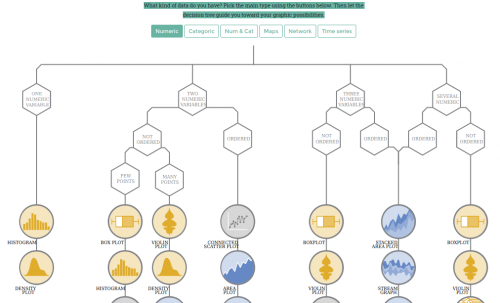
From Data to Viz leads you to the most appropriate graph for your data. It links to the code to build it and lists common caveats you should avoid.
What kind of data do you have? Pick the main type using the buttons below. Then let the decision tree guide you toward your graphic possibilities.
Uses and abuses of data visualizations in mass media
Data visualizations are a powerful way to display and communicate data that otherwise would be impossible to transmit in effective and concise ways. The spread of broadband Internet, the easier access to reusable datasets, the rise in read/write digital media literacies, and the lower barrier to generate data visualizations are making mass media to intensively use of infographics. Newspaper and online news sites are taking advantage of new, affordable and easy to access data visualization tools to broadcast their messages. How can these new tools and opportunities be used effectively? What are good practices regarding data visualization for a general audience?
After an introduction to a series of key concepts about visualizing data the lecture will follow with an analysis of a series of significant data visualizations (tables, pie and bar charts, maps and other systems) from TV, daily newspapers and news websites to detect good and bad practices when visualizing statistical information. The lecturer will then analyze recent literature of visualization studies regarding persuasion, memorability and comprehension. What are more effective embellished or minimal data visualizations? Does graphical presentation of data make a message more persuasive?
Color Survey Results
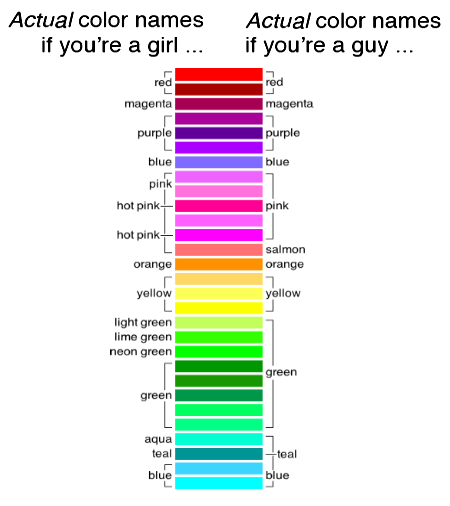
Basically, women were slightly more liberal with the modifiers, but otherwise they generally agreed (and some of the differences may be sampling noise). The results were similar across the survey—men and women tended on average to call colors the same names.
Color Naming Experiment

Each user was shown a random color and asked to type in a name. We asked people provide the most generic name possible, dropping things like modifiers (blue instead of light blue). Instead of using the entire RGB spectrum (millions), we pruned the color set to 216 « web safe » colors. This helped ensure every color had many responses. We left it online for a week or so and collected 6,276 color responses.
Influencers que no existen: el caso de Miquela, la robot instagramer
Miquela nace en 2016. Un perfil de Instagram daba comienzo a su historia: una joven hispano-brasileña, residiendo en Los Ángeles y proyectando identidad de IT-Girl comenzaba su rastro digital suscitando todo tipo de especulaciones (como que era una campaña para promocionar el juego Los Sims). Después de tres años ya sabemos un poco de qué va la historia: « un estudio transmedia que crea universos narrativos y personajes digitales ». Esto es lo que puede leerse en la escueta web (es un Google Doc en realidad) de presentación de Brud.
City Roads: mapas limpios de texto para usar en todo tipo de diseños
City Roads hace una sola cosa y la hace bien. A partir del nombre de una ciudad, toma los datos de OpenStreetMap y los vuelca en una espartana imagen bicolor sin texto alguno, con excepción de la ciudad en cuestión. Las únicas opciones que da son elegir esos dos colores: el de las calles y el del fondo.
The art of slow travel: the journey is just as important as the destination
Welcome to slow travel, the movement that goes back to what travel is all about – the journey, not the destination, the experience, not the social media post.
Slow travel started as an offshoot of the slow food movement, which itself began in Rome in the 1980s as a protest against a McDonald’s opening up in Piazza di Spagna. What started as the indignation of food-loving Italians turned into a celebration of traditions and culture, of authenticity and building connections – ideas that were all wonderfully ahead of their time.
In a world where we’re all too busy and too stressed, with too little time and too many emails, slow travel is like a deep breath of fresh air. It is our chance to step out of our lives and immerse ourselves in a different culture, to explore and soak up experiences.
China obliga a ‘escanear’ su cara a quienes compran una tarjeta SIM
gran parte de la población accede a internet desde dispositivos móviles. Por este motivo, al temor a un mayor control de la población se une el miedo a que los datos biométricos puedan filtrarse o ser robados. China es uno de los países en los que más se utilizan los sistemas de reconocimiento facial, tanto en el día a día como en el control de los ciudadanos.
La tiranía de la falta de estructuras
…la noción de grupo sin estructura se convierte en una cortina de humo que favorece a los fuertes ó a aquellas personas que pueden establecer su hegemonía incuestionable sobre los demás. Esta forma de hegemonia puede establecerse muy fácilmente porque la noción de falta de estructura no impide la creación de estructuras informales; solo lo impide de las formales.
…la falta de estructura feminista, es normalmente defendida por aquellas que tienen mayor poder (sean o no conscientes de ello). En la medida en que la estructura del grupo es informal, las normas de cómo se toman decisiones son sólo conocidas por unas pocas, y la conciencia de que existe una relación de poder se limita a aquellas que conocen las normas.
Las normas de cómo se toman las decisiones deben ser abiertas y conocidas por todas, lo que sólo ocurrirá si son formalizadas; esto no quiere decir que la formalización de la estructura de un grupo destruya necesariamente su estructura informal, normalmente no ocurre así, pero sí impide que la estructura informal tenga un control predominante, al tiempo que ofrece mejores medios para atacarlas si la gente involucrada no responde a las necesidades
generales del grupo.
Las élites son nada más y nada menos que grupos de amigas que, incidentalmente, participan en la misma actividad política…
Estos grupos de amigas funcionan con redes de comunicación al margen de cualquier canal que el grupo haya establecido con este fin y, si no existen canales, funcionan como la única red de comunicación; porque esta gente es amiga, porque habitualmente comparten los mismos valores y concepciones políticas, porque se hablan en circunstancias de la vida cotidiana, porque se consultan cuando tienen que tomar pequeñas decisiones sobre sus vidas, la gente que participa en estas redes tiene más poder que aquella que no participa.
…si se trabaja ocho horas o se tiene alguna obligación similar es normalmente imposible llegar a ser parte de la élite, simplemente porque no hay suficientes horas para asistir a todas las reuniones y cultivar las relaciones personales necesarias para tener voz en la toma de decisiones; ésta es la razón por la que las estructuras formales para la toma de decisiones son un regalo para las personas cargadas de trabajo. Contar con un procedimiento fijo para tomar decisiones garantiza, hasta cierto punto, la participación de todos y cada uno de los miembros.
Soste[vida]bilidad. Guía de trucos y remedios para un emprendimiento que ponga la vida en el centro
¿Cómo compaginar el sostenimiento de la vida y los cuidados con las exigencias de horarios, disponibilidad y flexibilidad que el emprendimiento requiere?
Una guía para introducir pequeñas modificaciones en nuestras rutinas del día a día, para que poco a poco, de manera colectiva y por efecto mariposa, se puedan producir cambios a gran escala, transformaciones más profundas.
One Small Step for the Web…
Solid, an open-source project to restore the power and agency of individuals on the web.
Solid changes the current model where users have to hand over personal data to digital giants in exchange for perceived value. As we’ve all discovered, this hasn’t been in our best interests. Solid is how we evolve the web in order to restore balance – by giving every one of us complete control over data, personal or not, in a revolutionary way.
Solid is a platform, built using the existing web. It gives every user a choice about where data is stored, which specific people and groups can access select elements, and which apps you use. It allows you, your family and colleagues, to link and share data with anyone. It allows people to look at the same data with different apps at the same time.
In 2009, I said, “The web as I envisaged it we have not seen yet.” That was because people were using the web just for documents, not for the data of a big web-wide computer. Since then, we have seen a wave of open data, but not of read-write data. For example, much open government data is produced through a one-way pipeline, so we can only view it. With Solid, it becomes a read-write web where users can interact and innovate, collaborate and share.
Chaos Computer Club
The CCC describes itself as « a galactic community of life forms, independent of age, sex, race or societal orientation, which strives across borders for freedom of information… ». In general, the CCC advocates more transparency in government, freedom of information, and the human right to communication. Supporting the principles of the hacker ethic, the club also fights for free universal access to computers and technological infrastructure as well as the use of open-source software. The CCC spreads an entrepreneurial vision refusing capitalist control. It has been characterised as « …one of the most influential digital organisations anywhere, the centre of German digital culture, hacker culture, hacktivism, and the intersection of any discussion of democratic and digital rights ».
Trunk for the fediverse
Trunk allows you to mass-follow a bunch of people in order to get started with Mastodon or any other platform on the Fediverse. Mastodon is a free, open-source, decentralized microblogging network.
Killed by Google
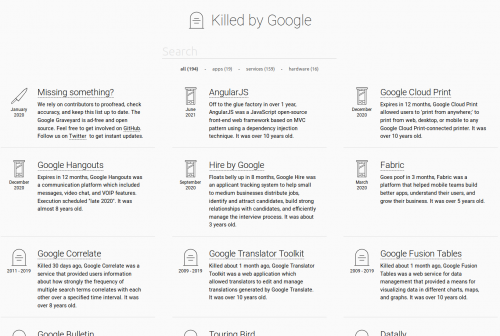
Killed by Google is the Google graveyard; a free and open source list of discontinued Google services, products, devices, and apps. We aim to be a source of factual information about the history surrounding Google’s dead projects.
Repositorio Estatal de Software Libre (RESL) del Gobierno de Bolivia
Es una herramienta de forja de software que permitirá a las entidades públicas y a la población en general alojar sus proyectos de software fomentando el desarrollo colaborativo de una comunidad o grupo de personas que buscan un mismo fin o tienen un mismo interés. Esto con el fin de alcanzar soberanía tecnológica de manera conjunta en el Estado, ahorrando recursos al reutilizar software común entre entidades.
France’s digital minister says tax on big tech is just the start
France is to become the first major economy to impose a tax on internet heavyweights. Dubbed the Gafa tax – an acronym for Google, Apple, Facebook and Amazon – the legislation will impose a 3% levy on the total annual revenues of the largest technology firms providing services to French consumers.
…tech giants, as monopolies, now presented a democratic challenge to governments. “Certain tech platforms have become the building blocks of our economy and democracy,” he said. “They have acquired a monopoly position today which gives them a footprint no other company has on the economy, so they need to see specific regulations applied … A company which has 1.4 billion citizens on its social networks can’t be treated like just any other company, with the same rules. A company that is the only search engine or messaging platform can’t have just the same rules as any other private company.”
The Telekommunist Manifesto
In the age of international telecommunications, global migration and the emergence of the information economy, how can class conflict and property be understood? Drawing from political economy and concepts related to intellectual property, The Telekommunist Manifesto is a key contribution to commons-based, collaborative and shared forms of cultural production and economic distribution.
Venture communism
Proposing “venture communism” as a new model for workers’ self-organization, Kleiner spins Marx and Engels’ seminal Manifesto of the Communist Party into the age of the internet. As a peer-to-peer model, venture communism allocates capital that is critically needed to accomplish what capitalism cannot: the ongoing proliferation of free culture and free networks.
Copyfarleft
In developing the concept of venture communism, Kleiner provides a critique of copyright regimes, and current liberal views of free software and free culture which seek to trap culture within capitalism. Kleiner proposes copyfarleft, and provides a usable model of a Peer Production License.
Encouraging hackers and artists to embrace the revolutionary potential of the internet for a truly free society, The Telekommunist Manifesto is a political-conceptual call to arms in the fight against capitalism.
Enabling HTTP/2 on Apache 2.4 on Debian or Ubuntu
Apache 2.4.17 ships with mod_http2. Available in Debian 9 (stretch) and Ubuntu 16.04 (Xenial Xerus) (see comments) Ubuntu 16.10 (Yakkety Yak), it brings HTTP/2 support to one of the Internet’s popular Web servers. Assuming you’ve already configured a SSL/TLS Website, this quick tutorial will show you how to quickly enable HTTP/2.
Hackbase
A Hackbase or Hackerbase is a Live-in Hackerspace – a hackerspace with a capacity for coliving.
everything you would expect from a hackerspace + place to stay (sleep, eat, …)
… this includes being publicly accessible (via a clear and non-discriminatory process)
able to host short or long-term stays
residents cover their own costs (which are usually far less than « normal » lifestyles)
extension on the practices of sharing already present in hackerspaces
hosts hacker Residencies and Exchanges
Totalism.org hackbase
CHT is an infrastructure project in Lanzarote (Canary Islands, Spain), researching, developing & practicing the transitional technologies, theory, tactics and arts of post-capitalism.
La tiranía de lo cuantificable
“la tiranía de lo cuantificable”, de la forma en la que lo que puede ser medido toma precedencia sobre lo que no puede serlo: el beneficio privado sobre el bien común; la velocidad y eficiencia sobre el disfrute y la calidad; lo utilitario sobre los misterios y significados más útiles para nuestra supervivencia…
La tiranía de lo cuantificable es en parte la incapacidad del lenguaje y del discurso para describir fenómenos más complejos, sutiles y fluidos, así como la incapacidad de aquellos que forman opiniones y toman decisiones para entender y valorar estas cosas más resbaladizas.
“Star Wars — El ascenso de Skywalker”: Fans, desertemos del imperio
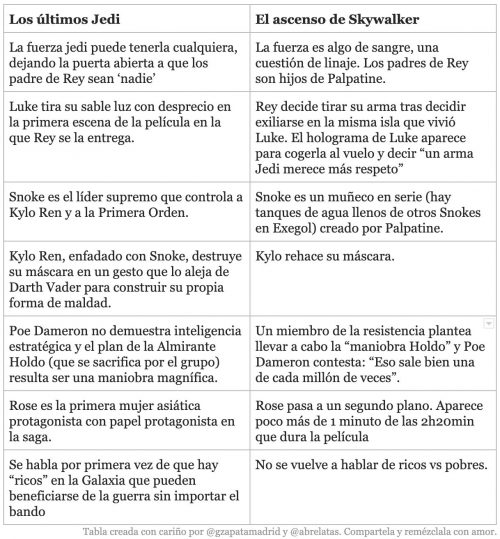
…aca-fans de Star Wars (fans que juegan a ser académicos o académicos que no se avergüenzan de ser fans, como bien ha defendido en numerosas ocasiones Henry Jenkins)
…una parte de los fans provocaron una guerra cultural contra “Los últimos Jedi” y además de defenestrar la película, consiguieron que Kelly Marie Tran (la actriz que interpreta a Rose Tico) abandonara las redes sociales tras recibir miles de insultos por su físico, su raza y por su papel en Star Wars. Resulta complicado no ver el cambio en el rol de su personaje como resultado de este proceso y por tanto como una victoria del ‘lado oscuro de los fans’.
Star Wars nunca ha sido obviamente un simple mito popular: especialmente tras la compra de Disney de los derechos y con la llegada de Internet, no hacer nada que pudiera poner en riesgo la mitología original para así poder preservar el imaginario que es representado en parques temáticos, series u otras películas, videojuegos o cómics y rentabilizar al máximo (económicamente) todo ese universo de ficción parecía algo que Abrams ‘declaraba’ indirectamente con “El despertar de la Fuerza”.
La fuerza no está peligro, el Imperio está en disputa. Disney es la dueña de la inmensa mayoría de la atención audiovisual del planeta, pero no es capaz de disciplinar y dirigir esa atención, necesita las singularidades que existen en la misma para seguir reproduciendo sus beneficiosos mundos de ficción.
Star Wars no ha terminado porque hoy en día y por más que se esfuercen, la industria no es capaz de poseer en su totalidad las historias. Las historias son complejos universos habitados por personas diversas, por variados intereses y disputas culturales. A nosotros, desde nuestro humilde lugar de aca-fans, nos gusta pensar que Star Wars aún puede ser otra cosa. Que puede ser más una república de fans que un imperio.
The D3.js Graph Gallery
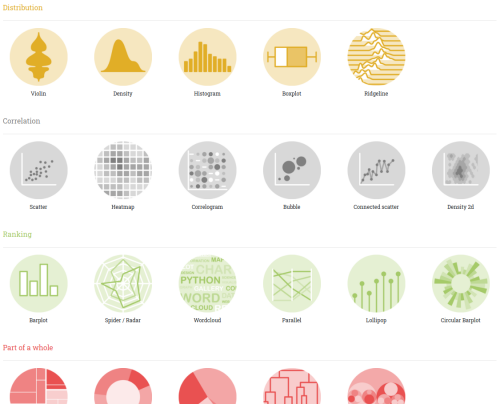
…a collection of simple charts made with d3.js.
This gallery displays hundreds of chart, always providing reproducible & editable source code.
Self-Signed_Certificate
The second step is to start creating the Certificate File. For that you can use the « openssl » command that will assist you in the process. The command is as follows
mkdir -p /etc/ssl/localcerts
openssl req -new -x509 -days 365 -nodes -out /etc/ssl/localcerts/apache.pem -keyout /etc/ssl/localcerts/apache.key
chmod 600 /etc/ssl/localcerts/apache*
Linux / Unix ncftp: Upload Directory Tree To Remote FTP Server Recursively
ncftpput -R -v -u « username » ftp.nixcraft.biz /nixcraft/forum /tmp/phpbb
Where,
-u « username » : Ftp server username
-v : Verbose i.e. show upload progress
-R : Recursive mode; copy whole directory trees.
ftp.nixcraft.biz : Remote ftp server (use FQDN or IP).
/nixcraft/forum : Remote ftp server directory where all files and subdirectories will be uploaded.
/tmp/phpbb : Local directory (or list of files) to upload remote ftp server directory /nixcraft/forum
¿De qué año es tu casa? El mapa que muestra cómo se ha construido España

El año en el que más se construyó en España fue 1960. Por primera vez en varias décadas, el país experimentó una estabilidad económica que permitió un pequeño salto en la calidad de vida. Coincidió con el éxodo rural, para el que hicieron falta nuevas construcciones que acogiesen a los recién llegados del campo, y con el origen de un turismo que capitalizaría la economía española hasta nuestros días. La época conocida como el ‘desarrollismo’ propició dos programas de planificación económica y social en torno a zonas industrializadas y de costa que dibujaron el desarrollo urbano de los años posteriores.
Según el castastro, el 17% de construcciones de todas las capitales de provincia data de esa década. Luego llegaron los PAU, que alejaron la vida del casco histórico de las capitales, las grandes urbanizaciones, la burbuja y, también, los cadáveres inmobiliarios de la crisis.
…la fabricación en cadena del Seat 600 hizo que el automóvil pasara de ser un artículo de lujo a una utilidad de clase media, dando lugar a un nuevo enfoque urbanístico: ¿por qué vivir en el centro si ya es posible hacerlo en una casa más amplia sin tardar más de 20 minutos al trabajo?
Nació así el fenómeno del ‘urban sprawl’ o la dispersión urbana, que dio lugar a casi todos los barrios fuera de la M-30, como Aluche, Móstoles o Vallecas, donde se construyeron principalmente edificios de ladrillo; o Fuencarral y Pozuelo, lugares al norte en los que proliferaron las primeras urbanizaciones de chalés.
…este nuevo concepto de Madrid supuso la ruptura de una ciudad centrada en la proximidad, en una ciudad dispersa, basada en el coche.
How to Submit My Website to DuckDuckGo Search Engine?
Unlike other search engines, DuckDuckGo doesn’t offer any kind of webmaster tools.
Duckduckgo also not offers URL submission.
So, Is there any way to submit your site to DuckDuckGo. Yes, they don’t have any kind of a crawler that is going to crawl your website. To index your site, you have to rely on the search results from other search engines and come up with a way to index your site.
There is no need to submit your site to duckduckgo also there is no way to submit.
As duckduckgo automatically index your site.
So, It might take some time to show your site on duckduckgo search Engine.
I have made a Youtube Tutorial on Google, Bing and Yandex Webmaster Submission. Have a look at that.
Understanding D3.js Force Layout – 1: The Simplest Possible Graph
This is part of a series of examples that describe the basic operation of the D3.js force layout.
…linkDistance tells the force layout the desired distance between connected nodes. It may seem strange that D3 doesn’t simply compel all links to be that distance. The force layout, however, takes other factors into account as well, which sometimes prevents it from achieving the exact link distance in all cases.
…charge, so named because it’s a property that acts like electrical charge on the nodes. With force-directed graphs in particular, charge causes nodes in the graph to repel each other. This behavior is generally desirable because it tends to prevent the nodes from overlapping each other in the visualization.
Laboratorios ciudadanos: espacios abiertos para crear comunidad
MediaLab Prado desarrolla y apoya la producción de proyectos culturales bajo la experimentación, las convocatorias abiertas y el aprendizaje estructurado en 24 grupos de trabajo y seis laboratorios. Para poner en marcha estas iniciativas cuenta con un presupuesto anual de dos millones de euros que aporta el Ayuntamiento de Madrid.
Para el doctor Adolfo Estalella, antropólogo e investigador de la Universidad Complutense de Madrid, estos espacios permiten alumbrar nuevos futuros, nuevas formas de relacionarnos. «Las ciudades están diseñadas de tal manera que la población está segmentada por edades donde es casi imposible que se mezclen unas con otras. Estos laboratorios invitan a repensar esa segmentación tan habitual», indica.
el grupo GenZ conformado por jóvenes entre los 13 y los 19 años que tratan de explicar a través de una baraja de naipes llamada AkaFamily,cómo la familia tradicional, conformada por el padre, la madre, los hijos y los abuelos, ha cambiado a familias donde hay dos padres o dos madres; donde sus miembros pertenecen al colectivo LGTBI.
SSH: What’s the difference or interplay between /etc/ssh/[host files] and ~/.ssh/[public key]
In all, the SSH connection requires two key pairs –
Your Client software checks the Server’s (host) public key against data the server sends encrypted with the host private key. This requires you to have a copy of its public key, which you’re handed at the first connection and your client stores if you approve of it.
The Server checks your authentication data encrypted with your user private key using the copy of your user public key that it has a copy of because you put it there (or had someone put there for you).
Cómo fomentar el pensamiento crítico de los adolescentes a través de la ciencia de datos
“La ciencia de los datos puede ayudar a formar a ciudadanos capaces de leer las noticias sin dejarse engañar por gráficos y datos maliciosos”.
“El tratamiento de datos para la resolución de problemas reales y la toma de decisiones debería ser una competencia transversal básica en todos los niveles educativos”, sentencia Teresa Sancho, directora del grado en Ciencia de Datos de la Universitat Oberta de Catalunya (UOC). “No es necesario crear una asignatura para ello; basta con introducir la perspectiva propia de la ciencia de datos en las distintas asignaturas que existen”.


